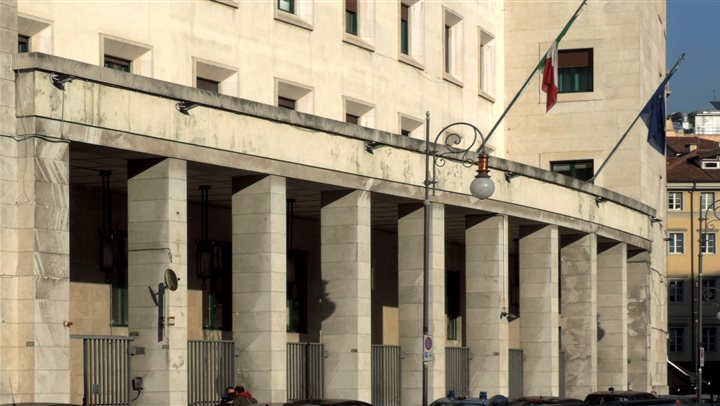The Palace of the Police Headquarters
The Palace of the Police Headquarters was originally designed as the house of the Fascist Party (Casa del Fascio) within the regulatory plan of 1934, with the aim to find an adequate headquarters for the local management of the National Fascist Party. Before that, the headquarters of the party was located in a small premise in Via D'Annunzio, and after that, on the first floor of the Verdi Theater.
The specific location, requested by the Party and the Authority of the time, Emilio Paolo Salem, was part of a larger project of urban restructuration for the old district (Cittavecchia), that included, among other changes, the creation of a new arterial road (Corso del Littorio, now Via del Teatro Romano), the removal of the old theater's ruins and the demolition of part of the Jewish ghetto.
The project competition for the House of the Fascist Party was carried out the same year, 1934. The project designed by the architects Raffaello Battigelli and Ferruccio Spangaro was chosen over another one created by Umberto Nordio and Giuseppe Pagano, who complained about the policy of the contests carried out by the fascist regime.
The first stone was placed by Mussolini during his visit to Trieste in September 1938, but the construction works didn't start until 1940. The official inauguration was celebrated despite the difficulties of war time, in 1942.
From 1945 to 1954, the building was the house of the Command of the Allied Military Government, and at the end of 1955 it became Trieste's Police Headquarters.
The Palace, adjacent to the complex of Assicurazioni Generali, overlooks the Roman Theater (Teatro Romano), has a curved front characterized by a colonnade and a wide terrace, which were specifically included in the original project in accordance to the roman ruins patterns.
The trapezoidal structure is divided in 5 floors. The top floor is outlined by the big windows of its angular defensive towers that might have a slight analogy to a quadriburgium, a military outpost placed at the borders of the territory in imperial Rome.
The windows, marked by slightly curved cornices in relief, together with the white limestone covering, provide an intended stark and institutional appearance.
The main entrance is situated at via Tor Bandena (under a colonnade that extends also to the side of Via del Teatro Romano) and gives access to the main atrium, which is covered by grey and brownish marble that includes a mausoleum with a honor staircase, originally reserved for the fascist hierarchy. The mausoleum contains the names of the fallen members of the police corps, among them, the police commissioner of Rijeca, Giovanni Palatucci "The Fair", who died at Dachau, on February 10th, 1945.
The main atrium was opened to the public in recent years, in accordance with the philosophy of the State police, which defends the importance of being closed to the people. It is used for artistic and cultural events (painting exhibitions, literary meetings, etc.)
It is possible to access directly to the Auditorium from a back entrance. This auditorium was open to the public in 1954, it was used as a room for the master Claudio Abbado in 1959, it was the seat of the Teatro Stabile di Trieste from 1962 to 1969, and it was declared inaccessible in 1985, due to its state of degradation.
Nowadays, there is a plan to reuse the 500 seats of the auditorium, given the actual difficulties of filling the 1,530 seats of Teatro Rossetti for works of prose, although some reconstruction works with a cost of around 2 million Euros would be necessary, a sum difficult to obtain at the moment.





